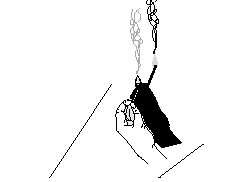Stick or book matches
Two dusty chalk erasers
Flashlight
Projector
Projection screen
Dark room
Procedure:
1. Darken the room and turn on the projector.
2. While standing in the projector beam, strike a match. Observe the shadows on the screen that are created by the smoke released by the combustion process.
3. Smack two dusty chalk erasers together and observe the shadows caused by the chalk dust.
4. Turn off the projector and turn on the flashlight. Stand against a dark background and stir up more chalk dust by slapping erasers together. Shine the flashlight's beam on the dust before it settles. Observe the brightness of the dust particles that are in the beam.
Discussion:
Dust and dirt in the atmosphere darken the sky during the daytime. These particulates come from both human and natural activities. Exhaust from internal combustion engines makes carbon monoxide gas, nitrogen oxide gas, and carbon (soot) particles. Industrial and home heating and forest fires, such as slash and burn agriculture, also contribute to the dust and dirt in the sky. Natural processes, like lightning-caused forest fires

and volcanic eruptions, add large amounts of dust and ash to the air. All these extra particles in the air not only filter out sunlight, causing redder sunsets and sunrises, but also increase "light pollution." Street, residential, and industrial night lighting reflect off particles and water vapor in the atmosphere to prevent the night sky from being really dark. However, many urban areas have begun to choose street lighting that interferes less with astronomical observations. Because of light pollution, observatories are usually located as far from urban areas as possible. Survey teams spend several months on candidate mountain tops observing weather patterns. They study particulates, wind, humidity, and temperature extensively before committing to the construction of an observatory.
For Further Research:
